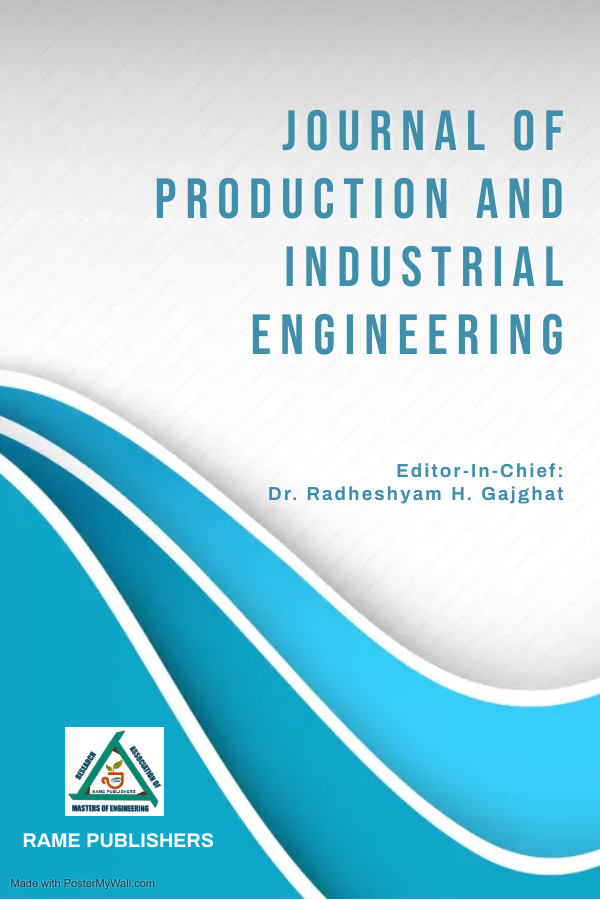Natural Bamboo Fibre Composites, their properties and its Applications - A Review
Roopesh Kumar, B Laxshaman Rao, Dr Abhijeet Ganguly, Dr. Rajesh Purohit
Journal of Production and Industrial Engineering
Volume 3: Issue 1, June 2022, pp 1-6
Author's Information
Roopesh Kumar1
Corresponding Author
1Department of Mechanical Engineering, CSIT Durg, India
roopeshsinha12@gmail.com
B Laxshaman Rao2
2Department of Mechanical Engineering, CSIT Durg, India
Dr Abhijeet Ganguly3
3Assistant Professor, Department of Mechanical Engineering, CSIT Durg, India
Dr. Rajesh Purohit4
4Professor, Department of Mechanical Engineering, MANIT Bhopal
Abstract:
In the present situation, there has been a fast consideration in innovative work in the Bamboo fibre composite field because of its better formability, copious, sustainable, financially etc. Bamboo fibre is a natural fibre that is easily degraded by microbes and potentially becomes an alternative fibre in the future due to its availability, which is abundantly cheap, and grows throughout the year and also isn’t affected by the season The application of bamboo fibre is a solution for environmental issues and a business prospect of synthetic fibres that are expected to decrease in line with petroleum. With this work, various values of bamboo have been considered as the basis, mechanical and chemical properties have been given the with major focus. On the basis of these values and qualities, the characteristic and utility of bamboo have been told. The symptoms of use of bamboo have been considered.Index Terms:
bamboo fibre, composite, mechanical strength, composite fabrication, synthetic fibre.REFERENCES
- Abdul Khalil H.S., I..H. Bhat, M. Jawaid, and A.Z. Hermawan. “Bamboo Fibre Re- in forced Bio composites: A Review.” Materials & Design. 42, 353-68. 2012.
Crossref - M, Ramesha, K. Palanikumar, & K. H. Reddy, “Plant fibre-based bio-composites: Sustainable and renewable green material, Renewable and Sustainable Energy Reviews” pp. 558–584, 2017.
Crossref - Mohanty K, Misra M, Drzal T, Selke E, Harte BR and Hinrichsen G. Natural fiber, biopolymers, and bio-composites: an introduction. In: Mohanty K, Misra M and Drzal LT (eds) . Boca Raton, FL Natural fibers, bio-polymers and bio-composites: CRC Press, Taylor & Francis Group, pp. 1–36.2005.
Crossref - John MJ and Thomas S. Bio fibers and bio composites. Carbohydr Polym 71(3): 343–364.2008.
Crossref - N.Venkateshwaran and A. Elayaperumal Banana Fiber Reinforced Polymer Composites - A Review Journal of Reinforced Plastics and Composites 2010 29: 2387. 2010.
Crossref - Michael Karus & Markus Kaup “Natural Fibres in the European automotive Industry”. Journal of Industrial Hemp, 119-131, 2002.
Crossref - T. Gutu, “A Study on the Mechanical Strength Properties of Bamboo to Enhance Its Diversification on Its Utilization”. International Journal of Innovative Technology and Exploring Engineering, vol. 2, no. 5, pp. 314-319, 2013
Online - Yang-Lun Yu, Xian-Ai Huang, Wen-Ji Yu “High performance of Bamboo-based fiber composites from long bamboo fiber bundles and phenolic resins” J. Applied polymer science, 131, 40371, 2014
Crossref - P. Kushwaha, K. Varadarajulu and R. Kumar, “Bamboo Fiber Reinforced Composite Using Non-Chemical Modified Bamboo Fibers”, International Journal of Advanced Research in Science and Technology, volume 1, no. 2, pp. 95-98, 2012.
Online - Li Y, Shan W, Huang Z, “Experimental study on mechanical behaviour of profiled steelsheet-bamboo plywood composite slabs”. Journal of Building Structures 2008;29.
Crossref - Li Y, Zhang W, Shen H, et al. “Experimental study on flexural behaviour of multiple-interlink profiled steel sheet bamboo plywood composite slabs”. Journal of Building Structures 2009; 30:176–81.
Crossref - Li Y, Shan W, Han T,.“Experimental study on mechanical behaviour of cold-formed thin-walled steel bamboo plywood composite slabs”.Journal of Harbin Institute of Technology 41:101–5. 2009.
Crossref - Shan W, Li Y, Li J, “Quasi-static test on profiled steel sheet-bamboo plywood composite walls”. Journal of Harbin Institute of Technology41:125–9 2009.
Onine - S.Siti suhaily, H.P.S. Abdul Khalil, W.O. Wan Nadirah and m.Jawaid Bambo based biocomposites materials, design and applications
Crossref - K.Okubo, T.Fujii and Y.Yamamoto, Development of bamboo based polymer composites and their mechanical properties, Composites, 2004, Part A: Applied Science and Manufacturing, 35, 377-383.2004,
Crossref - S Ahmed and Vijayarangan S. “Tensile, flexural and inter-laminar shear properties of woven jute and jute-glass fabric reinforced polyester composites”. Journal of MaterialProcess Technology 2008, 207, 330–335. 2008
Crossref - N. Kaur1, S. Saxena2, H. Gaur3, P. Goyal4“A Review on Bamboo Fiber Composites and its Applications” International Conference on Infocom Technologies, ADET, Amity University Dubai, UAE Dec. 18-20, 2017
Online - V. Kaur, D. P. Chattopadhyay, & S. Kaur, “Study on extraction ofbamboo fibres from raw bamboofibres bundles using different retting techniques”, TextLight Indian Science Technology, vol. 2, pp. 174–179. 2013.
Online - P Kushwaha, & R. Kumar, “Studies on performance of acrylo-nitrile pre-treated bamboo reinforced thermosetting resin composites”. J Reinforcement Plastic Composite, vol. 29, pp. 1347–1352. 2010
Crossref - Martijanti,Sutarno , Ariadne L, Juwono “Bamboo Fibers, Fabrication of Bamboo Fiber reinforced Composites, and their Mechanical Properties- A Review” International Journal of Emerging Trends in Engineering Research, Volume 8. No. 6, June 2020
Crossref
To view full paper, Download here
To View Full Paper
For authors
Author's guidelines Publication Ethics Publication Policies Artical Processing Charges Call for paper Frequently Asked Questions(FAQS) View All Volumes and IssuesPublishing with




